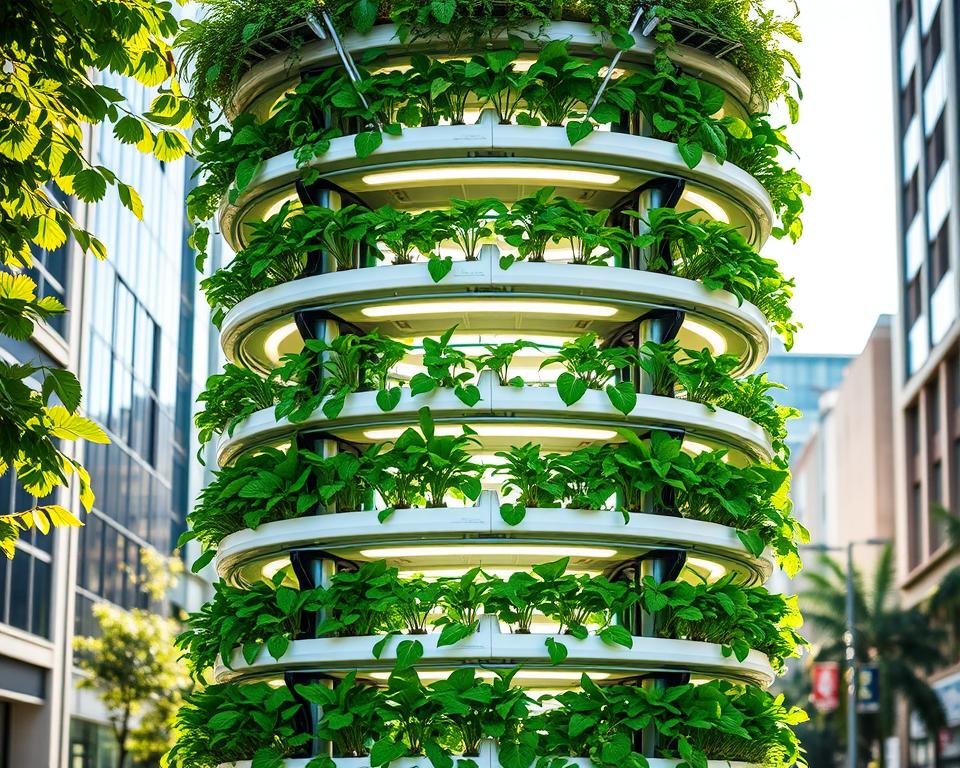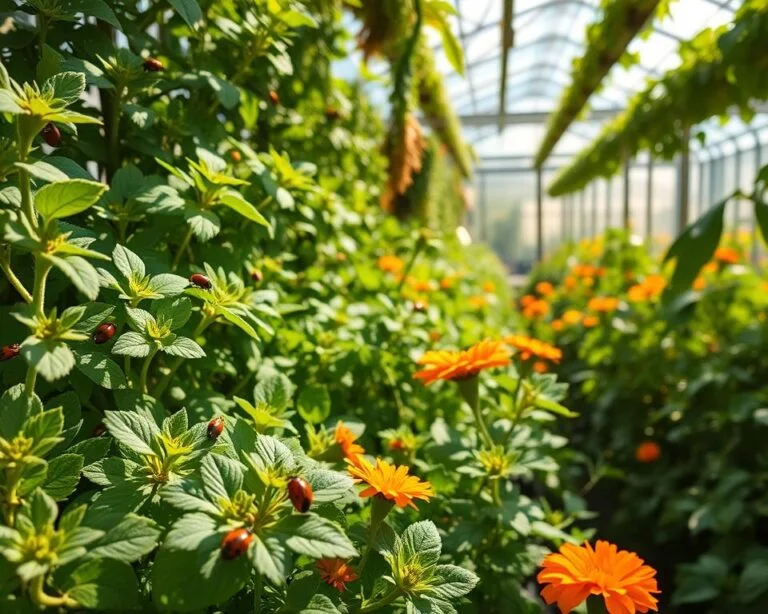Vertical Farming Tower: The Ultimate Space-Saving Gardening Solution
Imagine turning your small urban balcony into a garden that grows fresh veggies. The vertical farming tower is changing how city folks grow food. It turns small spaces into big food producers.
Vertical farming towers are a big deal in urban agriculture. They let you grow lots of food in a tiny area. You can even grow up to 10 times more food than with old-school farming.
Space-efficient farming is more than a trend; it’s a smart way to feed cities. Vertical farming towers let you grow food all year, no matter the weather. They’re great for city gardens where regular gardening is hard.
Key Takeaways
- Vertical farming towers maximize food production in minimal space
- Urban agriculture becomes accessible through innovative growing techniques
- Year-round crop production is possible with indoor vertical systems
- Significant water conservation compared to traditional farming methods
- Reduces environmental impact through efficient food production
Understanding Vertical Farming Technology
Vertical farming is a new way to grow food that tackles big problems in today’s farming. With more people and less land, new ways to farm are key for a sustainable food future.
Vertical farming has roots in ancient farming but has changed a lot with new tech. Now, farmers can grow food in small, stacked spaces. This method uses less resources but grows more food.
Core Components of Vertical Farming
Modern vertical farming uses several important technologies:
- Hydroponic growing systems
- LED lighting solutions
- Automated climate control
- Nutrient delivery mechanisms
Growing System Types
Vertical farming uses different ways to grow food:
| System Type | Key Characteristics | Water Efficiency |
|---|---|---|
| Hydroponics | Water-based nutrient solution | Up to 98% less water usage |
| Aeroponics | Nutrient mist delivery | Significant water reduction |
| Aquaponics | Integrated fish farming | Circular nutrient system |
Vertical farming technology lets farmers grow food in amazing ways. They can grow up to 240 times more food per square foot than old farming methods. By 2050, with 80% of the world’s population in cities, these new farming ways will be vital for feeding everyone.
“Vertical farming is not just about growing food—it’s about reimagining agricultural sustainability for future generations.”
Benefits of Vertical Farming Tower Systems
Vertical farming towers are changing the game in sustainable farming. They solve big problems in modern farming. These systems help a lot with food security and use resources wisely.

Vertical farming towers do more than traditional farming. They make food production much more efficient. Here’s how:
- They use up to 80% less land than traditional farms.
- They save a lot of water, using up to 98% less.
- They grow crops all year, no matter the weather.
- They need much less pesticide.
“Vertical farming represents the future of sustainable food production, addressing global agricultural challenges with innovative technology.”
Now, let’s look at the numbers:
| Metric | Vertical Farming Tower | Traditional Farming |
|---|---|---|
| Water Usage | 1-2 gallons daily | 50-100 gallons daily |
| Crop Yield | Up to 5x more produce | Standard yield |
| Electricity Consumption | 216 watts per day | Not applicable |
| Nutrient Density | 15-45% increase | Standard levels |
Using vertical farming technology helps a lot. It makes farming better and ensures we have enough food. These systems are great for cities, helping people grow food even if they’re not farmers.
Vertical farming towers can be used in many places. They work indoors and on rooftops. This makes growing food easy and accessible for everyone.
Smart Technology Integration in Modern Towers
Urban agriculture is getting a tech boost, with vertical farming towers getting smarter. These towers use advanced tech to grow plants better and work more efficiently.
Today’s vertical farming towers have tech that makes old farming look old-fashioned. They use smart sensors, AI, and monitoring to control everything.
Automated Irrigation Systems
Getting water right is crucial in vertical farming. Advanced systems give plants just the right amount of water and nutrients.
- Real-time moisture tracking
- Nutrient-specific delivery mechanisms
- Waste reduction through targeted watering
Climate Control and Monitoring
Now, indoor farming tech lets us control the environment exactly. AI systems keep an eye on everything and adjust as needed.
“Technology transforms vertical farming from an art to a science of precision and predictability.”
LED Lighting Solutions
LED lighting is a big deal for vertical farming towers. It’s energy-saving and lets us adjust light for each plant’s needs.
| LED Feature | Benefit |
|---|---|
| Spectrum Customization | Optimized Plant Growth |
| Energy Efficiency | Reduced Power Consumption |
| Long Lifespan | Lower Maintenance Costs |
With IoT tech, these towers can be managed from anywhere. This makes farming in the city more efficient and easy to handle.
Best Plants for Vertical Farming Success

Choosing the right plants is key when starting with vertical farming towers. Your garden can be both productive and fun with the right crops.
Top Performers in Vertical Hydroponic Systems
Some plants are perfect for vertical farming. They grow fast and produce a lot. Here are the best ones:
- Leafy Greens: Lettuce, spinach, and kale
- Herbs: Basil, mint, cilantro, and parsley
- Small Fruits: Strawberries and cherry tomatoes
- Microgreens: Sunflower, radish, and broccoli shoots
“In vertical farming, choosing the right plants can transform your small space into a bountiful garden.” – Urban Farming Expert
Hydroponics is great for city gardeners. Crops like microgreens grow fast. They can be ready in just 7-14 days.
| Plant Type | Growth Cycle | Yield Potential |
|---|---|---|
| Leaf Lettuce | 3-4 weeks | High |
| Basil | 4-6 weeks | Continuous |
| Strawberries | Continuous | Medium-High |
Pro tip for beginners: Start with easy-to-grow leafy greens and herbs. They quickly adapt to vertical farming and give you regular harvests.
Your journey in vertical farming can be very rewarding. With the right plants and hydroponics, you’ll turn your city space into a thriving garden.
Sustainable Features and Environmental Impact
Vertical farming is a new way to grow food that’s good for the planet. It offers smart solutions to big environmental problems. These systems can change how we grow food and make it better for our planet.

Water Conservation Methods
Your vertical farming tower can save a lot of water. It uses special irrigation systems that use 95% less water than old farming ways.
- Precision drip irrigation targeting plant roots
- Recirculating water management systems
- Moisture sensors for optimal water distribution
Energy Efficiency Measures
Vertical farming is all about using less energy. It uses special LED lights and smart climate control. This makes it use less power.
| Technology | Energy Savings | Impact |
|---|---|---|
| LED Grow Lights | Up to 40% reduction | Optimized photosynthesis |
| Smart Climate Control | 25% energy efficiency | Precise environmental regulation |
Waste Reduction Strategies
Vertical farming towers also cut down on waste. They use composting and follow the circular economy. This makes farming more eco-friendly.
“Vertical farming is not just about growing food—it’s about reimagining our relationship with agriculture and the environment.” – Agricultural Innovation Expert
By choosing vertical farming, you help solve world hunger and protect our planet. It’s a big step towards a greener future.
Conclusion
Vertical farming towers are a game-changer for growing food in cities. They can grow up to 144 plants per square meter. This is way more than traditional farming.
These systems turn small areas into green spaces that produce fresh food all year. It’s a great way to make the most of tiny spaces.
Smart tech is at the heart of vertical farming towers. They use advanced monitoring and AI to save energy and grow more food. LED lights help plants grow faster and stronger.
By using these technologies, you can have your own farm. You can grow veggies without needing a lot of land.
The future of growing food in cities is bright. The vertical farming market is set to hit $35 billion by 2032. North America is leading the way.
Joining this movement helps save money, water, and makes food production stronger. It’s a chance for everyone to grow their own food, no matter where they live.
Begin your vertical farming journey now. As tech gets better, these systems will cost less. By using vertical farming towers, you’re helping make farming better and more efficient. It’s a step towards solving global food problems.







